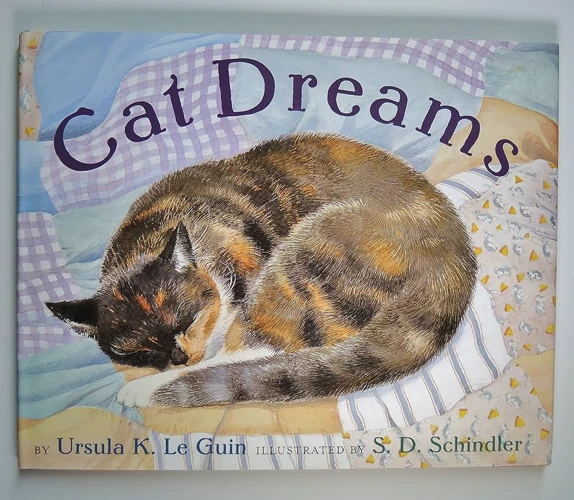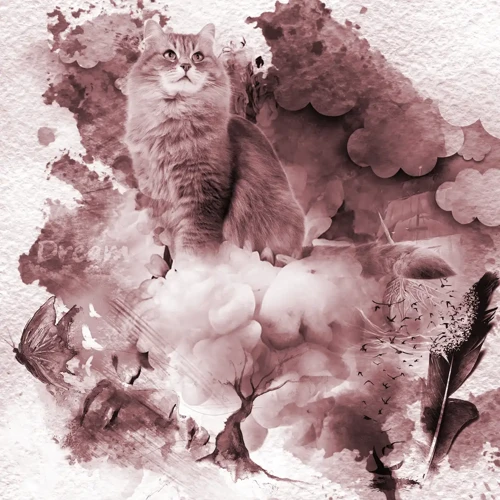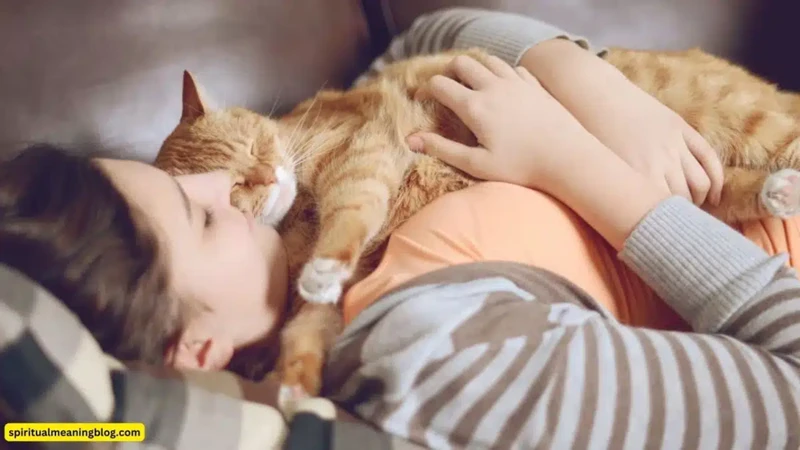Curiosity piques as we watch our feline friends toss and turn, paws twitching and whiskers atremble, during their mysterious slumber. As cat owners, we can’t help but wonder: what exactly goes on in the sleeping mind of our beloved furry companions? In this fascinating exploration, we delve into the science behind cat dreams and unravel the enigma of their sleeping adventures. Join us as we decipher their nocturnal experiences, shed light on common dream themes, and offer insights into interpreting these peculiar nighttime escapades. Prepare to be captivated and astonished by the hidden world of your cat’s dreams.
The Science Behind Cat Dreams

The Science Behind Cat Dreams uncovers the fascinating world of feline slumber. Researchers have discovered that cats, like humans, experience Rapid Eye Movement (REM) sleep, characterized by rapid eye movements beneath closed eyelids. During this stage, the brain is highly active, and dreams are believed to occur. Unlike humans, who spend about 25% of their sleep in REM, cats spend approximately 30% of their slumber in this dream state. The brain activity during cat dreams closely resembles that of their awake state, suggesting vivid and immersive mental experiences. This intriguing phenomenon invites us to explore what unfolds in their dreams and understand the secrets hidden within their sleeping minds.
1. REM Sleep in Cats
During REM Sleep in Cats, which stands for Rapid Eye Movement, felines display fascinating physiological and behavioral characteristics. This stage of sleep is characterized by quick and erratic eye movements beneath closed eyelids. Interestingly, during this phase, a cat’s brain becomes highly active, almost resembling the brain activity during their awake state. It is during REM sleep that dreams are believed to occur, providing insight into what they may be experiencing during their slumber. This deep dive into the REM sleep patterns of cats will uncover the captivating world of their dreams and shed light on the mysteries that unravel within their sleeping minds.
2. Brain Activity during Cat Dreams
The brain activity during cat dreams is a realm of intrigue and fascination. Studies have shown that during these dream states, a cat’s brain exhibits patterns similar to the ones observed when they are awake. Neurons fire rapidly, indicating heightened mental activity and potential dream scenarios. It is believed that cats may even simulate hunting behaviors within their dreams, as specific areas of the brain associated with predatory instincts show increased activity. While we can’t directly peek into their subconscious experiences, these findings provide a glimpse into the intricate and captivating world of feline dreams. To learn more about dreams, check out our article on /dream-about-a-python-snake/ and discover the hidden symbolism behind the slithering presence of a python snake.
Common Themes in Cat Dreams

Common Themes in Cat Dreams provide a window into the fascinating subconscious adventures of our feline companions. One prevalent theme is that of hunting and prey. Cats may dream about stalking, pouncing, and capturing elusive targets, even if they are well-fed domestic pets. Playful interactions and tussles also find their way into their dreams, reflecting their natural instincts and social behavior. Additionally, familiar places and routines often make appearances in their dreamscapes, showcasing their attachment to their environment and daily rituals. These themes shed light on the primal instincts and experiences that shape our cats’ dreams, offering a glimpse into their captivating nocturnal world.
1. Hunting and Prey
In the realm of cat dreams, hunting and prey take center stage. Cats have an innate predatory instinct, and this theme often translates into their dream world. As they doze off, their minds transport them to scenarios where they become skilled hunters, pouncing on elusive targets and engaging in chase sequences. Their dreams may feature imaginary creatures or replicate real-life encounters with birds, mice, or insects. This instinctual behavior is a reflection of their natural hunting skills and the satisfaction they derive from capturing prey. The intensity of these dreams can be observed through their body movements, where they may kick, twitch, or vocalize as they engage in their dream hunts. So, next time your cat peacefully snoozes, remember that in their dream realm, they are mighty hunters stalking their prey.
2. Playful Interactions and Tussles
Playful Interactions and Tussles are a common theme in cat dreams. As they slumber, cats often reenact their daytime activities, engaging in playful bouts with imaginary friends or even reliving moments spent with their feline companions. You may notice their paws twitching, ears flicking, and occasional gentle swats in the air as they vividly act out these dream scenarios. It’s fascinating to observe their dream world where they can chase after virtual prey or engage in friendly wrestling matches. These dreams may serve as a way for cats to sharpen their hunting skills or simply relish in the joy of playful interactions. Whether they dream about pouncing on that elusive laser pointer dot or engaging in a friendly wrestle, these dreams offer a delightful glimpse into your cat’s imaginative inner world.
3. Familiar Places and Routines
In the realm of cat dreams, familiar places and routines often take center stage. Just as humans often dream about familiar surroundings, cats may find themselves in dreamscapes that mimic their everyday environments. These dreams may feature their favorite napping spots, familiar rooms, or even their owners’ presence. Cats are creatures of habit, and their dreams may serve as a way to reinforce comforting routines and memories. As they sleep, it’s not uncommon to see them twitching their paws or softly purring, perhaps reliving a cherished moment spent lounging in the sunlit corner of the living room or curled up on their favorite blanket. These dreams provide a glimpse into the inner world of our feline companions, revealing the importance of their daily rituals and the comfort they find in the familiar.
Understanding Your Cat’s Dream Patterns

Understanding Your Cat’s Dream Patterns can provide valuable insights into their inner world. One way to observe their dreams is by paying attention to their body movements. During sleep, cats may twitch their paws, twitch their tails, or make subtle jerking motions, indicating an active dream state. Vocalizations and sounds can also provide clues about their dreams. Listen for purrs, meows, or even growls that may suggest the presence of dream scenarios. Additionally, keep an eye on their eyesight and pupil movements, as they may dart around beneath their eyelids or show rapid eye movements. By keenly observing these patterns, we may catch glimpses into the captivating dreamscapes that unfold in our cats’ minds.
1. Observing Body Movements
Observing Body Movements is one way to gain insights into your cat’s dream patterns. During sleep, cats may exhibit various physical movements that can provide clues about their dreams. Pay attention to their paws, which may twitch or make running motions as if chasing prey or engaging in playful interactions. Their body may also twitch, roll, or arch in response to dream scenarios. By carefully observing these movements, you can get a glimpse into the captivating world your cat ventures into during their slumber. Understanding these body cues contributes to unraveling the enigma of what truly captivates their dreaming mind.
2. Vocalizations and Sounds
Vocalizations and sounds play a significant role in deciphering a cat’s dream patterns. While cats are silent hunters in the waking world, they may produce a variety of sounds during their slumber, from gentle purrs to intense meows and even chirps. These vocalizations can indicate the types of dreams they are experiencing. For example, a series of rapid meows could suggest a dream of chasing prey or engaging in a playful interaction. Paying attention to the sounds your cat makes during sleep can provide valuable insights into the content of their dreams and offer a glimpse into their imagined adventures. So, the next time you hear your slumbering feline vocalize, take a moment to appreciate the secret symphony unfolding in their dream world.
3. Eyesight and Pupil Movements
The movement of their eyes and pupils provides valuable clues about a cat’s dream state. During sleep, cats may exhibit rapid side-to-side eye movements, similar to humans during REM sleep. These rapid eye movements suggest the presence of vivid visual experiences in their dreams. Additionally, their pupils may flicker and dilate, indicating intense mental activity occurring within their slumbering minds. These visual cues further emphasize the immersive and dynamic nature of cat dreams. To gain a deeper understanding of your feline companion’s dreams, observing their eye movements and changes in pupil size can provide intriguing insights into the visual landscapes they explore during their nocturnal adventures.
Interpreting Cat Dreams

Interpreting Cat Dreams can be a challenging endeavor, as we can only speculate about their meaning. Symbolic meanings and context play a crucial role in deciphering their dream experiences. For example, if your cat dreams about hunting and capturing prey, it may represent their natural instinct and hunting prowess. However, considering environmental factors is also crucial in interpretation. Cats may dream about familiar places and routines, reflecting their daily experiences. It is important to note that interpreting cat dreams is subjective and can vary from one cat to another. While we may never fully comprehend the complexities of their dream world, observing their behaviors and providing a safe and comforting sleeping environment can support the sweetest dreams for our feline companions.
1. Symbolic Meanings and Context
Symbolic Meanings and Context play a significant role in interpreting cat dreams. Cats are known for their symbolism in various cultures, with different interpretations assigned to their behaviors and characteristics. When deciphering their dreams, it’s essential to consider the context of the dream, such as the environment or recent experiences. For example, if a cat dreams about chasing a mouse, it could symbolize their instinctual hunting nature or a desire for control in their waking life. Understanding the symbolism and context behind their dream experiences can provide valuable insights into their subconscious thoughts and emotions. So, let’s delve deeper into the fascinating realm of cat dreams and explore the hidden meanings that may be lurking within.
2. Considering Environmental Factors
Considering Environmental Factors plays a crucial role in interpreting your cat’s dreams. The surroundings and experiences your cat encounters in their waking life can influence their dreams. For example, if your cat frequently interacts with other animals, they may have dreams involving social interactions with fellow feline or non-feline friends. Similarly, if your cat loves exploring outdoor environments, their dreams might feature outdoor settings or encounters with wildlife. Creating a stimulating and enriching environment for your cat can enhance their dream experiences and provide them with a wealth of content to explore during their slumber. By taking into account the environmental factors that shape their waking life, we can gain a deeper understanding of the rich tapestry of their dream world.
Tips for Promoting Sweet Dreams
To ensure our feline companions have sweet dreams, there are a few tips we can follow. First and foremost, providing a safe and comfortable sleeping environment is essential. Cats appreciate warm and cozy spots where they can curl up and feel secure, so consider providing soft bedding or a cat bed in a quiet corner of the house. Engaging in interactive playtime during awake hours can also help promote restful sleep. Play sessions not only alleviate boredom, but they also provide an outlet for physical and mental stimulation, helping to tire out your cat before bedtime. Lastly, establishing a consistent and calming bedtime routine can signal to your cat that it’s time to wind down and prepare for sleep. This may include gentle brushing, a soothing petting session, or even dimming the lights in the evening. By implementing these tips, we can enhance our feline friends’ sleep quality and contribute to their overall well-being.
1. Provide a Safe and Comfortable Sleeping Environment
Creating a safe and comfortable sleeping environment is essential for promoting sweet dreams for your feline companion. Start by providing a cozy bed or a soft blanket where your cat can curl up and feel secure. Consider the location of the sleeping area, ensuring it is in a quiet and low-traffic spot to minimize disturbances. It’s important to keep the sleeping area clean and free of any potential hazards. Avoid placing objects that could potentially fall and startle your cat during sleep. Additionally, make sure the temperature is ideal for your cat’s comfort. Cats are sensitive to fluctuations in temperature, so aim for a warm and consistent environment. By prioritizing your cat’s comfort and safety, you create the perfect setting for them to embark on tranquil slumbers undisturbed by the outside world.
2. Engage in Interactive Playtime During Awake Hours
Engaging in interactive playtime with your feline friend during awake hours is crucial for promoting sweet dreams. Playtime not only helps cats release their pent-up energy but also stimulates their natural hunting instincts. Use interactive toys such as feather wands, laser pointers, or treat-dispensing puzzles to keep them active and engaged. This type of play mimics real prey and allows cats to engage their physical and mental faculties. By satisfying their primal instincts during playtime, you provide them with a sense of fulfillment and contentment, contributing to a more restful sleep. Regular play sessions also strengthen the bond between you and your feline companion, creating a deeper sense of trust and security. So grab that wand or puzzle toy and let the playtime adventures begin!
Note: No relevant anchor for internal linking was found in the given text.
3. Establish a Consistent and Calming Bedtime Routine
Establishing a Consistent and Calming Bedtime Routine for your cat is essential in promoting sweet dreams. Cats thrive on routine, so creating a predictable nighttime ritual can help them relax and prepare for sleep. Set a specific time for bedtime and engage in calming activities such as gentle play, brushing, or cuddling. Create a serene environment by dimming the lights and providing a cozy and comfortable sleeping spot. Avoid loud noises or stimulating activities close to bedtime. This routine will signal to your cat that it’s time to wind down and prepare for a peaceful slumber. By incorporating this consistent and soothing bedtime routine into your cat’s life, you can effectively contribute to their overall well-being and improve their sleep quality.
Conclusion
In conclusion, delving into the world of cat dreams has provided us with fascinating insights into the mysterious slumber of our feline companions. While we may never fully grasp the intricacies of their dreamscapes, we now understand that cats experience REM sleep and have active brain activity during their dreams. The common themes observed in their dreams, such as hunting, play, and familiar routines, give us a glimpse into their inner worlds. By observing their body movements, vocalizations, and pupil movements during sleep, we can gain a better understanding of their dream patterns. It’s important to remember that interpreting cat dreams requires considering symbolic meanings, context, and environmental factors. By creating a safe and comforting sleeping environment, engaging in interactive play, and establishing a calming bedtime routine, we can promote sweet dreams for our curious and imaginative feline friends.
Frequently Asked Questions
1. Do cats dream like humans do?
Yes, cats do experience dreams similar to humans. They go through a sleep cycle that includes REM (Rapid Eye Movement) sleep, which is often accompanied by dreaming.
2. How can I tell if my cat is dreaming?
Observing your cat during sleep can provide clues. Look for twitching paws, whisker movements, and rapid eye movements beneath closed eyelids. These are indications that your cat may be dreaming.
3. What do cats dream about?
The content of cat dreams is still a mystery. However, common themes in cat dreams often include hunting, playful interactions, and familiar places or routines.
4. Can cats have nightmares?
While it is difficult to determine if cats have nightmares, some cats may display signs of distress during sleep, such as hissing or growling. This could suggest the possibility of a negative dream experience.
5. Should I wake up my cat if they are having a bad dream?
It is generally best to let sleeping cats lie. Waking them abruptly from a dream can startle or confuse them. Instead, provide a comforting environment when they wake up.
6. Do kittens dream differently than adult cats?
It is believed that kittens and adult cats experience similar dream patterns. However, since kittens are still developing, their dreams may involve more exploration or playfulness.
7. Can cats physically act out their dreams?
Yes, cats have been known to physically react to their dreams by twitching, running in place, or making small movements with their paws. It’s their way of engaging with the dream world.
8. Are there any signs of deep sleep in cats?
Cats enter deep sleep, also known as non-REM sleep, after the REM sleep stage. During this stage, their muscles relax, and their breathing becomes slower and more regular.
9. Can cats dream about specific experiences or people?
While it is uncertain if cats specifically dream about people, they can dream about experiences they have had, such as hunting or playing. These dreams may evoke memories of certain people or interactions.
10. How can I ensure my cat has sweet dreams?
Creating a safe and comfortable sleeping environment for your cat, engaging in interactive playtime during awake hours, and establishing a consistent and calming bedtime routine can contribute to promoting sweet dreams for your feline friend.







